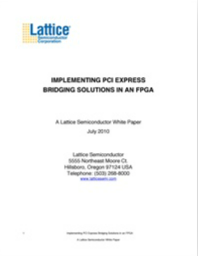IMPLEMENTING PCI EXPRESS BRIDGING SOLUTIONS IN AN FPGA
Like its predecessor, the Peripheral Component Interconnect (PCI), PCI Express is becoming a ubiquitous system interface. Unlike PCI, PCI Express adopts a Serializer/Deserializer (SERDES) interface to provide users with the scalability required for future applications. As system bandwidths increase, more applications are moving to SERDES-based interfaces like PCI Express.
Several new FPGAs families now offer very attractive options to designers. FPGAs provide an extremely flexible platform without the long lead times and large NREs typically associated with ASICs or the inflexibility of ASSPs.
Download this whitepaper to find out more.
Read More
By submitting this form you agree to Lattice Semiconductor Corporation contacting you with marketing-related emails or by telephone. You may unsubscribe at any time. Lattice Semiconductor Corporation web sites and communications are subject to their Privacy Notice.
By requesting this resource you agree to our terms of use. All data is protected by our Privacy Notice. If you have any further questions please email dataprotection@techpublishhub.com
Related Categories: Components, Embedded, Evaluation boards, Power, Processors, Switches

More resources from Lattice Semiconductor Corporation
LEVERAGING FPGA AND CPLD DIGITAL LOGIC TO IMPLEMENT ANALOG TO DIGITAL CONVERTERS
An Analog to Digital Converter (ADC) is a common analog building block and almost always is needed when interfacing digital logic, like that in an ...
DESIGNING FOR LOW POWER
Power consumption is becoming an increasingly important variable when it comes to calculating OPEX and carbon footprint for telecom infrastructure ...
Solving Today’s Interface Challenges With Ultra-LowDensity FPGA Bridging Solutions
Designers are implementing a wide variety of interface bridging solutions that allow them to transfer data across protocols and, in the process, ex...
